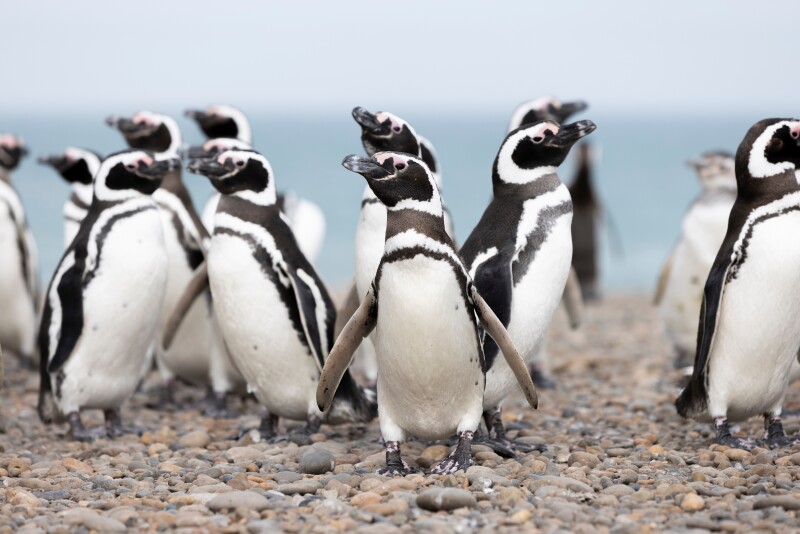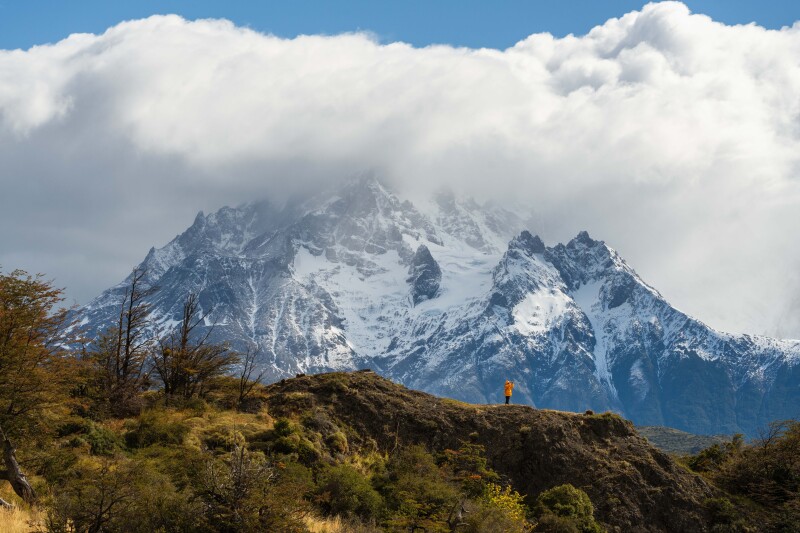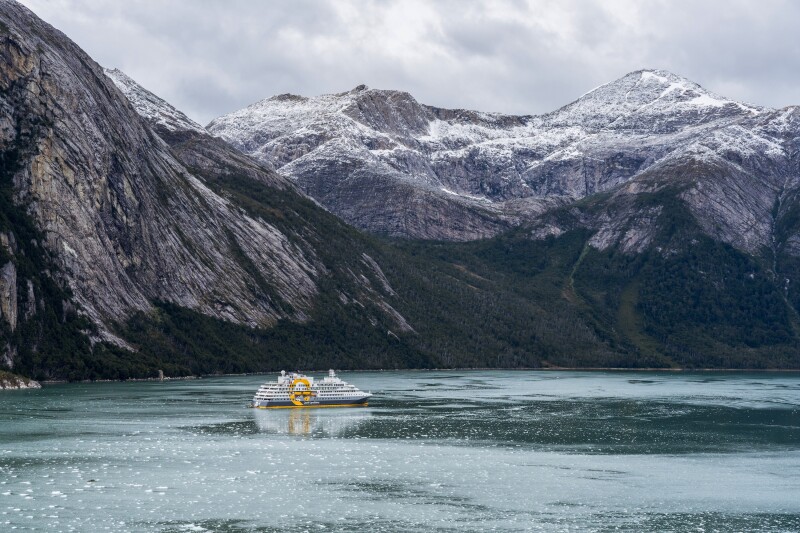The low-hanging clouds reached their misty tendrils toward us, dousing us in a cool bath of rain. But 10 days into our Patagonian adventure, a little water—OK, a lot of water—wasn’t enough to deter us from heading out on a Zodiac tour around the Tucker Islets, a small cluster of islands and outcrops in the Strait of Magellan inhabited primarily by Magellanic penguins. And for that, we were duly rewarded.
After 30 minutes, enough rain had seeped through the cracks in my waterproof layers that I removed my hood, only to be splashed in the face by . . . “Dolphins!” squealed a guest in my boat. A bow-riding pod of Dusky dolphins, to be exact. Absolutely drenched and delighted, we couldn’t help but smile and laugh as the cetaceans frolicked around us. As if that weren’t enough, the clouds parted enough to reveal a rainbow in the late afternoon sunlight.
After spending several all-too-brief layovers in Patagonia en route to Antarctica, I finally decided to dedicate more time to the region. But I wanted to see more than the ultra-popular Torres del Paine National Park, so I embarked on a two-week Patagonia expedition cruise with Quark Expeditions, sailing aboard the 199-guest Ultramarine.
While Quark primarily operates in the polar regions, the company expands to subpolar destinations during the shoulder seasons, before the fleet repositions to the other side of the globe. So following five months in Antarctica, Ultramarine and her crew were pining for the fjords of Chilean Patagonia.

Patagonia may not be as rich in wildlife as other expedition cruising hot spots like the Galápagos, but among the animals you will find in the region are Magellanic penguins.
Photo by Freedom_wanted/Shutterstock
Why Patagonia is an emerging expedition cruise destination
Expedition cruising plays an essential role in bringing guests to remote destinations that are often inaccessible by any other mode of transportation, immersing them in that destination’s flora, fauna, geology, and human culture, if it exists. Naturally, this style of travel suits the polar regions and far-flung island groups like the Galápagos.
But with expedition cruising exploding in popularity, repeat visitors to the high latitudes and the equator, or travelers put off by the extreme cold, notoriously unpredictable seas, and overtourism in fragile environments, might wonder what else is out there beyond the icy wilds of Antarctica, the picturesque settlements in Greenland, and the wildlife spectacle of the Galápagos.
The answer, it seems, is the places between. While Patagonia might be best known for its treks through Torres del Paine National Park, or perhaps the estancias (cattle ranches) on the sweeping steppe, the lesser-visited vast fjord system on the west side of the Andes is an expedition cruising paradise. Chilean Patagonia has more than 60,000 miles of coastline, more than 40,000 islands, and some 200,000 acres of glaciers—much of which is only accessible by boat or helicopter. (Conveniently, Ultramarine has two of the latter on board.)
Quark’s itinerary has even caught the eye of scientists looking to hitch a ride. The operator has partnered with the University of Magallanes in Punta Arenas to help conduct research during its Patagonia voyages. One multi-year project includes collecting core samples from glaciers to measure snow accumulation, the main contributor to glacial growth. On my trip, specifically, marine biologist and oceanographer Rodrigo Torres from the Research Center on Patagonian Ecosystems (CIEP) collected water samples from the fjords to measure the overall health of the marine ecosystem, from the nutrients fueling the marine food web to ocean acidification caused by carbon dioxide dissolving in water.

Sailing in Patagonia typically offers ample opportunities for hiking in Chile’s striking Torres del Paine National Park.
Photo by Singh Nicolas/Courtesy of Quark Expeditions
Exploring Patagonia by sea
Our journey began not in Chile, but in Ushuaia, Argentina, the main departure point for Antarctica cruises and one of the world’s southernmost cities. As with most ships sailing to Antarctica, we cruised west on the Beagle Channel, a strait connecting the Atlantic and Pacific oceans, en route to the Drake Passage. But rather than sail south across the Drake, we swung right toward Chile’s Cape Horn, the southernmost headland of South America’s Tierra del Fuego archipelago, where the Atlantic and Pacific meet. While we had hoped to land, the infamous heavy seas and high winds here thwarted us.
One of our regional experts, Chilean glaciologist, geophysicist, and mountaineer Camilo Rada, told me it’s quite typical—even he hadn’t set foot on Cape Horn yet after a handful of attempts. Instead, we completed a full circumnavigation of the island in the morning, taking in the wind, spray, and the first of many rainbows we’d see throughout the voyage. Given the conditions, we returned to the shelter of the Beagle Channel that afternoon and were welcomed warmly by hundreds of sei whales feeding, their blows like ethereal dancers, stretching as far as the eye could see.
On the east end of the Beagle, the glaciers took the spotlight. In a fairly short stretch of the channel, five glaciers descend from the Cordillera Darwin range to the sea, casting off icebergs into the turquoise water. It’s difficult to understand the glaciers’ immensity until you go flightseeing above them, which I did on the third day of the expedition during an included helicopter excursion. From my prime seat next to the pilot, I watched the altimeter tick, tick, tick—we had ascended thousands of feet, yet we weren’t anywhere even near the summit. And when we finally made it, I looked over the ridgeline below to see even more glaciers cascading down to the sea.
That afternoon, I was finally able to go ashore for the first time since departing Ushuaia two days earlier. Despite the passenger demographic skewing toward retirement age, this was an active bunch that took full advantage of our time on land. Many of our landing sites were in national parks, meaning there were well-marked trails along glacial moraines, past rushing rivers, atop rocky outcrops, and through forests for us to enjoy. In some spots, we foraged for berries (under the watchful eye of our very experienced guides). In others, we listened to the thunderous roar of ice calving off a glacier.

Guests have the chance to sample the region’s traditional grilled meats.
Photo by Singh Nicolas/Courtesy of Quark Expeditions
One of the highlights of Quark’s itinerary is a two-day call at Puerto Natales, a backpacker-friendly town of some 20,000 people that serves as the gateway to Torres del Paine. It became our home base for full-day land tours to the national park and a traditional estancia. In our case, the timing of the tides required us to head for port a day early, allowing for extra sightseeing time, to dine off the ship, and stretch our legs. Somehow I managed all three in a single day, covering nine miles on foot between a stroll around the Mylodon Cave Natural Monument, an afternoon poking about boutiques and art galleries in town, and dining on asado, or grilled meat. For fine dining, plan ahead and make a reservation at the Singular Patagonia, a luxury hotel just outside of town. Or opt for casual fare at El Asador Patagónico on Puerto Natales’ main square.
After so much activity, my favorite moment of the trip—besides the dolphin encounter—was a moment of quiet on the 11th day of the journey. At Bahia Ainsworth, a bay in Alberto de Agostini National Park, an expedition guide led a grounding meditation. All too often, I find it difficult to stop my brain from chugging along. But here, lying on a pebble beach between the forest, the sea, mountains, and glaciers, I found myself absolutely present and at peace. On a Patagonia expedition cruise, you’re not traveling to check boxes. You’re here to feel the wind tickling your face, hear the sea lap the shore, smell the earthiness of the peatlands. And there’s no better way to soothe an overstimulated soul.
What to know before going on a Patagonia cruise
First and foremost, Patagonia is a landscape destination. Visitors will find themselves with jaws agape at the striking jagged mountain peaks, looming glaciers, and slick icebergs, all set to the backdrop of moody, misty weather—this is a photographer’s dream adventure. But be prepared for that weather. The Andean peaks catch the moisture in the air that blows off the Pacific Ocean on strong winds, making it rain a lot. In my two weeks in the region, we had only two rain-free days.
As for wildlife, well, Patagonia is no Galápagos. But the relative infrequency of sightings makes each and every one even more exciting. On several occasions Andean condors—one of the largest birds in the world, with a wingspan reaching up to 10.5 feet—circled on thermals above us. On one Zodiac outing, a kingfisher sat on a branch just above eye level, scanning the water below for a meal, unperturbed by our presence. On another, we turned a corner to find a colony of Magellanic penguins clinging to a cliff side.
And though Patagonia might not be as remote as other expedition cruising destinations, it can somehow feel more remote at times. Unlike in Antarctica or Greenland, there aren’t dozens of expedition ships in the area. In fact, we only saw one—Chilean operator Australis‘s Stella Australis—plus local ferries and fishing boats. Tourism, it seems, is fairly limited here, which is exactly why expedition cruising suits Patagonia so well.

Not all cruise departures from Ushuaia, Argentina, aim toward Antarctica.
Photo by Singh Nicolas/Courtesy of Quark Expedotions
How to cruise in Patagonia
Expedition cruise lines offer Patagonia itineraries ranging from 5 to 17 days in length, sailing between various port cities across Chile and Argentina, from Santiago to Ushuaia. Here is a sampling of the voyages available in the region.
- Antarctica21: Patagonia & Chilean Fjords Sea Voyage; nine days, from $5,995 per person
- Australis: Fjords of Tierra del Fuego; five days, from $1,695 per person; and the Patagonian Explorer; five days, from $1,695 per person
- Aurora Expeditions: Patagonia and Chilean Fjords; 15 days, from $11,277 per person
- HX (Hurtigruten Expeditions): Chilean Fjords—Discovering the Heart of Patagonia (southbound); 14 days, from $6,948 per person, or Chilean Fjords—Discovering the Heart of Patagonia (northbound); 14 days, from $6,939 per person
- National Geographic–Lindblad Expeditions: The several itineraries include Classic Patagonia: Glaciers and Peaks; 9 days, from $12,130 per person; Southern Patagonia: Glaciers, Fjords and Wildlife; 17 days, from $22,315 per person; Chilean Patagonia: Fjords, Glaciers and Torres del Paine; 14 days, from $28,450 per person; and Patagonia: Chilean Fjords and Argentina’s Staten Island; 10 days, from $13,588 per person
- Quark Expeditions: Essential Patagonia Chilean Fjords and Torres del Paine; 15 days, from $12,321 per person











